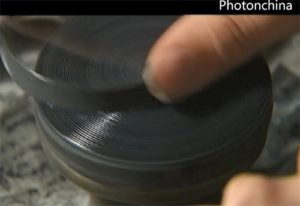Double-sided grinding and polishing, performed with particles suspended in a liquid vehicle to abrade parts equally from both surfaces, is suitable for batch production which has relatively lower demands on optical specifications.
Precision pitch grinding and polishing, also known as single-sided lapping and polishing, is ideal for high precision optics which has stringent requirements on surface quality, flatness, parallelism etc.
About pitch polishing
Pitch polishing is a similar concept to the lapping process except it is using a pitch plate and much finer polishing media.
Photonchina uses single-sided polishing methods for a variety of optical components: quartz waveplate, filters, prisms, windows, mirrors as well as crystals like BBO, LBO,YVO4, etc.

Typically, components range in size from 10mm diameter to 800mm diameter. Other sizes are achievable depending on both machine and component size and type.
Significant skill is required for pitch polishing, achieving tighter tolerances for surface quality, flatness, parallelism than you would achieve using both-sided polishing, let alone the conventional lapping process with coarser abrasives.
Notably, the pitch polishing process also minimizes surface deformation on the edge of a part also known as edge roll.
Pitch plates are a semi-malleable surface, often hand-poured, with a consistency similar to bitumen (asphalt), or roofing tar. Concentric, spiral, radial and cross-hatched grooving is usually hand cut to allow the polishing slurry to flow beneath components, resulting in exceptional surface quality and surface flatness.
Pitch polishing is a non-deterministic trial-and-error process and combines both art and science. The highly-experienced optical technicians at Photonchina have extensive knowledge and rich experience of the optical polishing process and can provide consistent, high quality components.
Pitch Polishing Manufacturing Limits
| Specifications | Measurements |
| Diameter | ≤ 800mm |
| Surface Roughness | ≥ 3 Å rms |
| Parallelism | 3 arc seconds |
| Surface quality (MIL-PRF-13830B) | 10-5 |
| Reflected Wavefront Error (RWE) – before coating | ≥ 1/20 wave over clear aperture |
| Transmitted Wavefront Error (TWE) – before coating | ≥ 1/20 wave over clear aperture |
| Wedge Angle Tolerance | ± 3 arc seconds |
